John Goheen, principal-Pilgrimage of Remembrance guide
“It wasn’t about the ‘wow factor’ of war, thinking it was somehow exciting or thrilling; it was always born out of remembrance.”
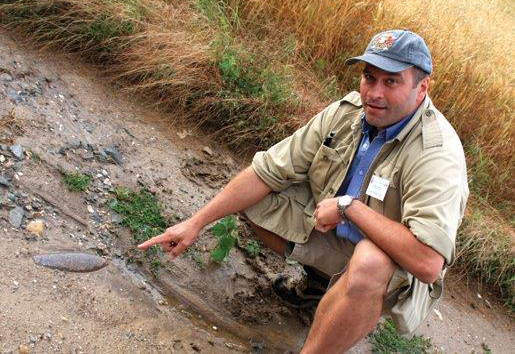
Many mornings in Port Coquitlam, B.C., before the workday begins, John Goheen gets up. While his wife and daughters sleep, he brews a pot of coffee and quietly slips into his home office. There, he joins his 1,500+ history books, all on the First and Second World Wars, and sets about his passion: deepening his knowledge of Canadian military history, and preparing to make that knowledge as personal as possible for the people he guides for the Royal Canadian Legion Dominion Command Pilgrimage of Remembrance.
Since 1996, John has served as the Legion’s official tour guide. But his interest in remembrance reaches back to the early 1970s, when he was only a boy growing up in Vancouver, B.C.
“Lots of people in our family were in the First and Second World Wars,” he says. “My grandfather on my mother’s side fought in the First World War, dad’s father—my grandfather—fought in the Second World War, lots of great uncles and other relations were involved in both wars. But very little was ever said about it when I was a kid, which was not unusual back then… What changed things for me was when I was about seven years old, my dad took me down to the cenotaph for Remembrance Day. I remember being quite moved, especially looking at what I thought were very old men from the first war; they would have been in their late 70s, but to a little kid, they seemed so much larger than life. I was really struck by them.”
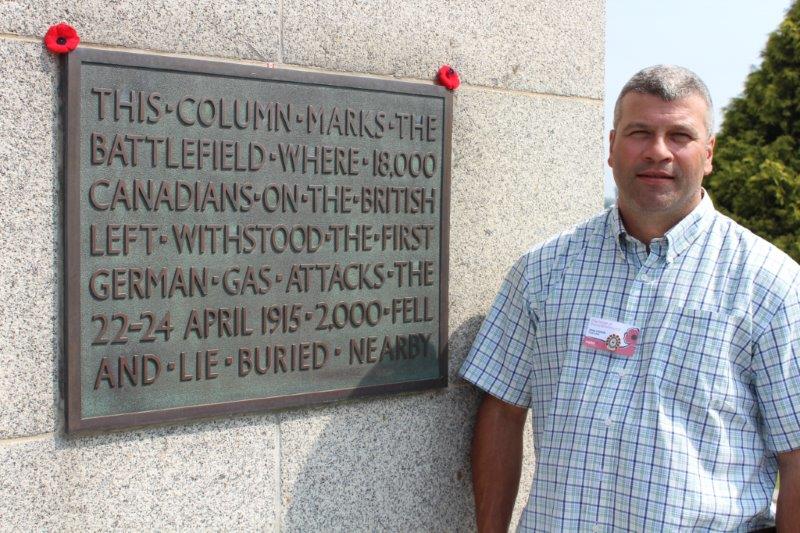
At the St. Julien Memorial at Vancouver Corner, Ypres Salient battlefields, Belgium, July 2013
John calls that a defining moment in his life, not only because it ignited his thirst for learning about military history, but also because of how it did so. “My interest was piqued within the context of remembrance,” he says. “Lots of people are interested in (the wars) these days, and always have been. But for me, as a kid, it wasn’t about the ‘wow factor’ of war, thinking it was somehow exciting or thrilling; it was always born out of remembrance.”
That November 11 had an immediate impact on his life. In his youth, he struggled with reading. His parents and two elder brothers were all avid readers, but John says he had what would today be diagnosed as a learning disability. Still, his desire to learn about the war was unquenchable. So he became a fixture at the local library. “I would take books off the shelf that I could barely carry, let alone read,” he says. “I would sit there and pour over pages, pick out pictures and images.”
His love of books went so deep that he started saving his allowance to buy them—the inaugural entries to his now-mighty collection. “The first one I bought was a biography of Billy Bishop, a First World War fighter pilot,” he says.
By his early teens, John was as avid as reader as anyone in his family, if not more so. He immersed himself in history books, boning up on “specific accounts of key battles in both wars, primarily Canadian, just trying to get a knowledge base,” he says. “It was for no purpose at that time; I was just keen to keep reading and learning.”

At one of the panels of the missing at Vimy Memorial, identifying his relative Walter William Goheen, one of 11,000 Canadians “missing presumed killed,” France, July 2011
History lessons
When John graduated from Centennial Secondary School in 1984, he enrolled at Simon Fraser University, completing a Bachelor of Education (with a history major) in 1990. He says he flirted with the idea of joining the military, something he looks back on as a bit of a “coulda, woulda, shoulda thing.” But he realized it wasn’t his calling. “At the end of the day, I don’t take orders very well.” He also knew there was something else that needed his attention.
“Teaching came quite naturally to me,” he says. “I got into teaching because I knew there had to be a way of reaching kids differently than how I was taught… Whatever approaches I took to engage my students had a lot to do with the lack of engagement I felt at school. I was a kid with learning disabilities; I struggled. I felt like no one really knew me. (I think teachers thought), ‘There’s John, nice kid, not very great at academic side of things.’ I remember in high school history class, sitting there bored out of my mind. I was a very quiet kid, but the teacher asked a question and I got kind of fed up because no one knew the answer, so I just told him the answer. And he and looked at me incredulously and said, ‘How do you know that?’ He’d never asked me before.
“(Going into teaching), I just thought, ‘If you’re going to spend all that time at school, you want to walk out of there feeling like you’re worth something, that you’re learning something, that you have some control or choice over how you’re learning.’”
John isn’t talking about some “free-for-all.” But he was, and is, determined to learn from his own history so he can help youth benefit from a more balanced educational experience—an environment where teachers engineer learning opportunities for different students based on their specific needs.
“My experiences as a student really motivated me when I was a young teacher to try to engage kids differently,” he says. “To find out where those sparks are, what they know, what they want to learn, how can you help them… My dad told me once, and it’s very true, that there are some teachers who are very interested in having you know how much they know, and other teachers who are more interested in finding out what you know. There’s a bit of humility that comes with that.”
Humility—and not just a bit of it—carries through all that John does. At work, when he shares his devotion to remembrance and his great knowledge of Canadian military history, he’s careful not to impose his interests; instead, he organically works them into the schools’ existing Remembrance Day programs, letting students come to him to ask questions when they’re ready.
At all the schools he has worked, he’s left a legacy of remembrance, of honouring our veterans, who risked everything to preserve and improve our way of life. He did so as a teacher at Harbour View Elementary School and Kwayhquitlum Middle School, then as vice-principal at Pitt River Community Middle School, and finally as principal, first at Alderson Elementary School and now at Rochester Elementary School. (John also fit in a Masters of Education from Simon Fraser University, which he completed in 2003.)
Beyond instilling an appreciation for remembrance, he has done a lot to foster school cultures that provide “a happy, productive place for kids and adults to work.” He deliberately didn’t become a history teacher (“I loved the topic too much to turn it into a job”), but he always brought an equal passion to every subject he taught—writing, art, electronics, cooking, math—and looked for creative ways to pique students’ interest. For instance, he never used a textbook to teach math. “I found it limiting to use only one thing,” he says. “I tried to bring in all kinds of approaches to help kids with math, to contextualize it and really try to get kids engaged and understanding.”
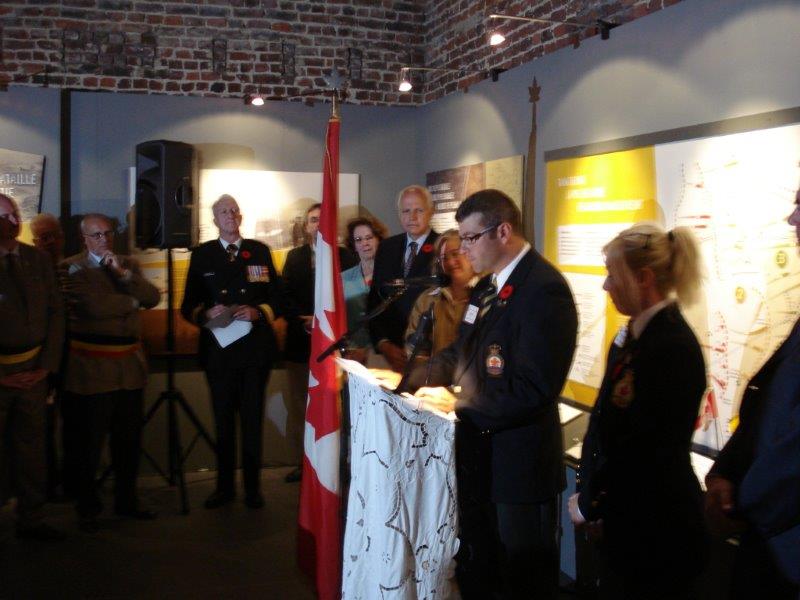
Delivering the opening address at Waterfields for the 90th anniversary of Passchendale, 2007
A context of remembrance
John’s involved and experiential approach to formal education spills over to his volunteer work guiding the Royal Canadian Legion’s Pilgrimage of Remembrance.
“To me, the most important thing is something I call informed memory,” he says. “It’s the idea that, by experiencing places firsthand and learning about them when you’re there, you can develop a bit of a connection. Anything that I put on the tour, any site we see, I look at as gateways to the past. You never know which gateway is going to connect for which person, so you try to provide a real variety of gateways and opportunities for people… It’s different for everyone, but a place or something that’s said within the place, all of a sudden something will hit them, and the comment I always get is, ‘I thought I knew a lot about this stuff but it’s never hit home like it did when I was there at that moment.’
“That’s why context is so important. I don’t try to fill heads with facts; people can do that themselves. I try to provide memories and context… It’s really about making that personal connection to the historical events. So I look for personal gateways and try to tell specific stories. There’s an old house in Normandy that most tours would pass by, but there’s an old house with marks in the side of the wall. Well, those marks were made by a tank that went rearing around the corner, went up on one side and clipped the corner. Why was the tank there? That provides a gateway to a whole story of the engagement the Canadians were involved in during the early days of Normandy. When you can touch that track, you’re never going to forget that story and you don’t forget the context of that battle.”
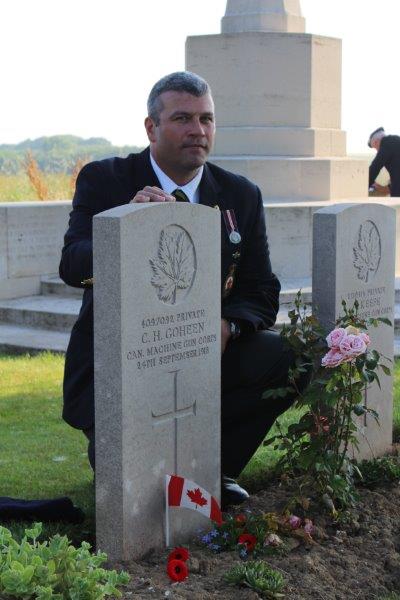
Behind the tomb of his great uncle Charles H. Goheen, killed in action September 22, 1918; July 2013
Giving voice to those scarce heard
John’s outstanding efforts have made a mark as lasting as the ones etched into that old house in Normandy. When I asked him to help me gather a few testimonials from people who had taken his tours, there was an outpouring of lengthy messages, detailing many wonderful experiences with John as a guide. Here are a few snippets:
“It was an honour and a privilege to be part of the 2013 Royal Canadian Legion Pilgrimage of Remembrance, and the experience would not have had the same impact on me if it were not for John Goheen. To put it simply, what is often a two-dimensional experience becomes 3-D in technicolour with John. His love of history, his fervent research and his diligence in locating obscure locations where our Canadians had a story to be told, brought events of WWI and WWII to life. Imagine standing in the middle of a cornfield, where a couple of dozen Canadian soldiers were cut down by the Nazis in the days following D-Day, as only two men managed to escape the slaughter and make it to a copse of maples some hundreds of yards away—trees still visible to this day. Imagine weeping as you realize you are standing where Canadian blood was shed in service to King and country. This is but one example of many; John took us on a 15-day journey through two wars and countless stories of heroism, tragedy and national pride.” —Belinda Wilson, Zone Commander, Zone F-4, Ontario Command; Lindsay, Ont.
“Under the tutelage of John Goheen, Tour Guide Extraordinaire, I not only saw the horrors of war during the ensuing and exhausting two-week period, but learned also of the valours of war, and saw firsthand where the dark consequences of hatred and strife took place… (The other participants and I) all headed home with a deeper appreciation of the sacrifices that others made for our freedom, and for the unquestionably precious nature of life, which millions of people currently enjoy.” —Sam Newman, 145 Vimy Branch, RCL; London, Ont.
“John doesn’t only have the knowledge, he has the heart that brings the stories of the wars to life, that wraps the participants in the stories and the terrible human cost of the tragedy of war. Statistics are cold and impersonal things, but every ‘one’ in a statistic is a person, and John tells the stories in terms of the individuals who fought.” —Brenda Fredrickson, Board Member, Wounded Warriors Weekend Foundation; Regina, Sask.
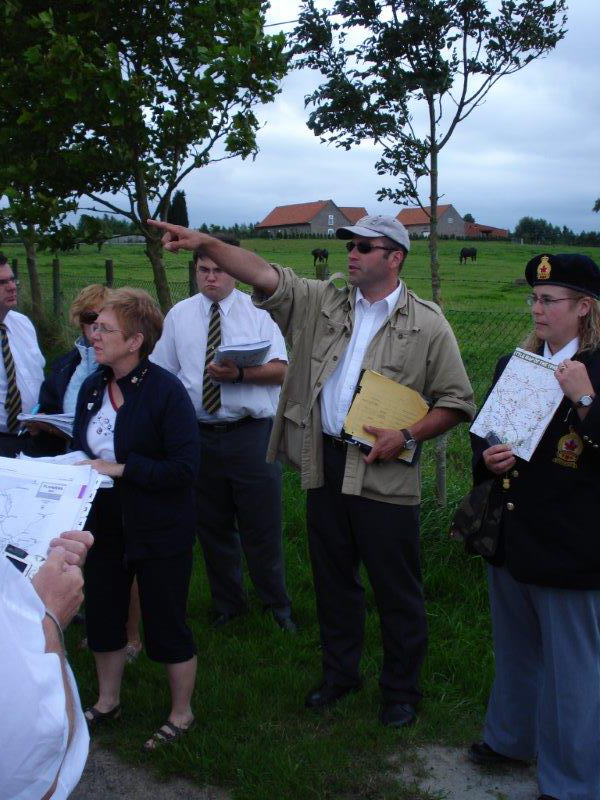
Guiding a tour at Le Quesnel Memorial, Somme, France, July 2009
While John was busy launching his career in the education system, it’s clear he pursued his interest in remembrance with equal commitment. He became an associate member of the Royal Canadian Legion in 1991, and participated in his first Pilgrimage tour in 1995 as the B.C. Command Representative.
He calls his first tour “a whirlwind—12 straight days of touring, seeing hundreds of different things, it was all just a jumble. I had a good sense of the history, but I imagine someone who was new to this would be completely overwhelmed. I found it overwhelming.” That first tour covered a lot of ground; starting in France, they took a ferry into Dieppe and toured through Normandy. Then they made their way into Somme and around Arras and Vimy, before heading north to Ypres, Belgium and into the Netherlands.
Overwhelmed and whirlwinded though he may have been, his expansive knowledge still impressed the Legion president, who came along for the 1995 tour. By the end of 1996, John moved past the ranks of B.C. representative and was invited to become the official tour guide for the next Pilgrimage in 1997.
Since then, he has had an unforgettable impact on hundreds of Pilgrimage participants. In the months leading up to every tour he leads, he spends countless hours, even days and weeks, reviewing his history books and compiling notes and documents, all to make each participant’s experience as informed and personalized as possible. He reads up on their deceased relatives and locates where their headstones lie; learns which battles they fought and identifies the fields where they took place.
The Pilgrims aren’t the only ones taking note of John’s efforts. In 2008, he was awarded the Legion’s highest honour, the Meritorious Service Medal. In 2012, he received a commendation from the Minister of Veterans Affairs Canada, an honour generally reserved for veterans, as well as the Queen Elizabeth II Diamond Jubilee Medal for his “significant contributions to Canada.”
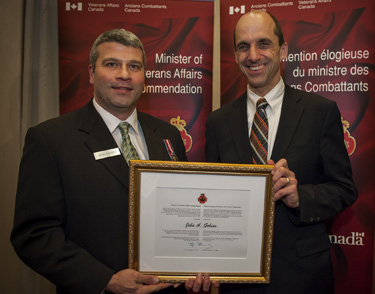
John (left) receives his commendation from then-Minister of Veterans Affairs Steven Blaney, 2012
“That was rather nice,” says John, ever humble. “You don’t do these things for awards, but it was very nice that somebody thought to put my name in.”
Recognition truly isn’t a factor. Since receiving the medals, just as he did before them, John continues his early morning routine of reading up on history before preparing for his present. That present includes running Rochester Elementary; spending time with Leslie, his wife of 12 years, and their daughters Megan (10) and Ava (6), as well as his daughters from a previous marriage, Jennifer (20) and Leanne (16); playing a little hockey and tennis; and never forgetting to honour those who made it possible for him to enjoy the life he has.
Keeping that top-of-mind, John is working with the Port Moody Station Museum to develop their upcoming McKnight Centennial Trench, a three-year exhibit scheduled to open July 1, 2015. And he has been commissioned to design and write all historical features for this year’s edition of the Royal Canadian Legion/BC Yukon Command’s annual Military Service Recognition Book.
This July, he’ll lead another Pilgrimage, taking people from across Canada to tour Europe: France, Belgium and Holland. He’s determined that the sacrifice our veterans made will not be lost on future generations. “I think Canadians of today have a hard time appreciating what the generations before them did in the First and Second World Wars,” he says. “There’s a huge debt. It’s a debt I don’t think we can ever repay, but I think by remembering, we’re at least showing that what they did mattered. To me, it’s really about a way of giving back. Living a good life and being mindful of what’s been done for you is a way of saying thank you.
“Every day we get up and enjoy peace and freedom. I think you have to stop and say, ‘What did I do to deserve this?’ Maybe nothing; but other people did for you.”
Lest we forget.
* * *
To connect with John, email [email protected]. For more about his work with remembrance, read the articles he wrote for The Tri-Cities Now.
You can visit legion.ca for information on how to join the Pilgrimage or become a member of the Royal Canadian Legion.
Thank you to Port Coquitlam’s Dan Gibson for recommending John as a Kickass Canadian.
 Kickass Canadians
Kickass Canadians
Thank you very much Amanda for this informative and inspiring profile. John Goheen truly took the torch and holds it high, in remembrance and gratitude.
My pleasure, Catherine! He’s doing so much for Canadians. His trips sound incredible.
Canada is a great country. We owe a tremendous debt to those Canadians who sacrificed everything to maintain our freedoms, our way of life. We can never repay that debt, but as John’s story suggests, we can honour their sacrifices through remembrance and by striving in our daily lives to maintain the integrity of our freedoms and build on the greatness of Canada.
What inspired me to nominate John Goheen was not that he was a high profile star of Canadian sport, politics or cinema, it was because he epitomizes what we all aspire to be as Canadians… humble, hard working, well-intentioned, contributing members of our society; John does this in spades. By day John is a principal, doing everything he can to improve the education and the lives of our children. During his free time, John selflessly dedicates hundreds of hours in preparation for his WWI and WWII tours (not to mention all of his other volunteering efforts). He does it not for awards or recognition, rather all that he does is motivated by the belief that it is to the benefit of those around him and to the betterment of his country.
John is a Kickass Canadian!
Thank you, Dan! I’m very glad you saw fit to nominate John. 🙂
What an accomplished man! Makes one want to sign up for one his tours and take along everyone you know!
Congratulations, John, from your proud family.